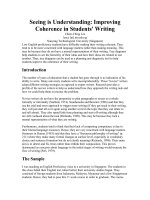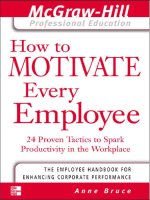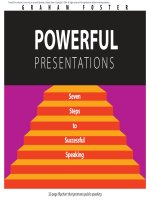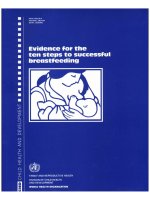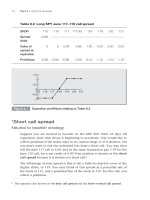Simple Steps to Successful Revision in L2 Writing.doc
Bạn đang xem bản rút gọn của tài liệu. Xem và tải ngay bản đầy đủ của tài liệu tại đây (80.01 KB, 5 trang )
Simple Steps to Successful Revision in L2
Writing
Catherine Coleman
englishtutor [at] clmn.net
California State University (Long Beach, California, USA)
About This Handout
Often second language students struggle with the editing and revision portion of the writing
process. They focus first on the grammatical issues in the paper and overlook important
structural problems. This handout offers a systemic organized format that students can
follow to analyze and revise their own work. For this handout, global revision consists of
an overall analysis of the structure and content of an essay; surface revision consists of an
analysis of the paper's grammar, punctuation, word usage, etc. at the sentence level. There
are two sections under each revision category: the first, Questions to Ask, includes a list of
questions that students can ask themselves about their essays; the second, Revising
Strategies, provides specific methods that students can immediately employee in their
writing.
Global Revision: Questions to Ask
The Introduction
• Is there an attention getter, such as a quote, anecdote, allegory, etc.?
• Is it necessary?
• Are the points clear?
• Do they lead logically to the thesis?
• Is there a clear recognizable thesis?
• Where is it located in the paragraph?
• Is that the optimum location?
The Thesis
• Is it a complete sentence?
• Does it assert or argue a topic? Does it take a position?
• Is the language clear?
• Does it have or need a counter argument?
• Is it too broad or too narrow for the limitations of the assignment?
• Is it located in a logical position within the paragraph?
The Paragraphs
• Does each paragraph have a topic sentence that reflects back or argues/explains a
point of the paper's overall thesis?
• Do the subsequent points of each paragraph focus on the main ideas of the
paragraph's topic sentence?
• Does each paragraph advance the paper in a logical and systematic way?
• Are the paragraphs too long? Are there too many points or examples within each
paragraph?
• Are the paragraphs too short? Is there specific supporting evidence to back the
argument?
• Are there too many or not enough quotations? Are the quotations explained in
relationship to the thesis and the argument?
• Do the paragraphs stay on the thesis topic?
• Does the order of the paragraphs follow a logical sequence?
• Is there any counter argument? Is it necessary?
• Do the paragraphs illustrate or prove the claim of the thesis?
The Conclusion
• Are there new points of argument within the conclusion? If so, is this the
appropriate place for them?
• Are the main points of the argument restated in an interesting way?
• Is the conclusion simply a summary or does it draw some conclusion from the facts
presented in the paper?
• Is the last sentence of the paper memorable or weak?
Global Revising Strategies
Pointing Finger
Copy the thesis onto a separate sheet of paper. Read the thesis and then read a paragraph.
Do this for each of the paper's body paragraphs. Ask yourself: Is the paragraph relevant to
the thesis? Does it advance or prove the thesis? Is there any information within the
paragraph that doesn't relate to the thesis? This strategy can also be used within each
paragraph to check each paragraph's topic sentence and main points.
Topic Sentence Coherence
A strategy to test the overall coherence and balance of a paper is to copy the thesis of the
paper and each topic sentence (generally the first sentence of each paragraph) and the paste
all the sentences into one paragraph. Then read the paragraph. Do the ideas flow logically
or do they jump around randomly? Are all points of the argument covered adequately; is
the argument balanced? Or does one section of the paper outweigh the rest? If the sentences
seem out of order, the paragraphs will be out of order which will weaken the effectiveness
of the paper.
Reverse Outline
This is another strategy to check the overall order of the paper's information. Read each
paragraph and sum up the main idea in one or two words. Then look at the order of the
words. Is the information presented in a logical manner? Are there gaps in the linear
sequence of the argument? If so, it might be necessary to add information or even rearrange
the paragraphs for clarity.
Color Coordinating
This is especially effective in comparison/contrast or pro/con argumentation papers. Use
different color highlighters to identify the main points of the paper. Analyze the
information by colors. Do they contrast color by color (point by point) or in large blocks
(block comparison)? Do the colors seem organized in a logical manner or do they appear
random and confused? Would changing the colors (thus points or paragraphs) improve the
structure of the argument?
Topical Analysis
For each paragraph, first identify the topic sentence, and then identify the subject, verb, and
object in each sentence in the paragraph. Once this information has been accumulated,
verify the logical progression of ideas from sentence to sentence as well as the relevance to
the topic sentence.
Surface Revision: Questions to Ask
Word Choice
• Is the spelling correct?
• Are the correct forms of words being used? Consider contractions (it's/its,
we're/were, etc.) and homonyms (there/their/they're, our/hour, one/won, etc.).
• Are any words repeated too many times?
• Is there variety in the transitions? Is the correct transition being used? For example,
however means on the contrary; therefore means in addition too.
• Is the language clear?
Verb Tense
• Does every sentence have subject/verb agreement?
• Are the verb tenses consistent throughout the essay?
• Is the correct verb being used? Is there variety in the verbs?
Punctuation
• Are all the sentences complete with subject and verb?
• Are there comma splices? Run-on sentences?
• Is the punctuation surrounding the quotation marks correct?
• Is the use of any semicolons or colons correct?
Source Citation
• Which documentation style is being used?
• Is there a variety in use of sources including paraphrase, summary, and direct
quotation?
• Are the quotations explained?
• Are the authors being referred to by their last name and are the names spelled
correctly?
• Are all references to outside sources documented correctly?
• Are there any block quotations? Is the format correct?
• Are the page numbers correct for the sources being used?
• If the source has a URL, is it correct? Is it active? When was the last time it was
checked? Are the Internet URL citations in the same font color (black) as the rest of
the paper?
• Is the bibliographic information page following the correct format (MLA, APA,
Chicago, etc.)?
• Has each citation been checked for exact placement of periods, commas,
parentheses, etc.?
• Does every citation in the paper have a corresponding citation on the bibliographic
page?
• Are the sources on the bibliographic page that are not used in the paper?
Miscellaneous Questions
• Does the paper follow the assignment spacing guidelines?
• Is the page length within assigned limits?
• Is the font type and size within the assigned guidelines?
• Is a title page required? If so, is the format correct?
• Are footnotes or endnotes required? If so, is the format correct?
• Does the Header or Footer follow the assignment guidelines?
• Is the professor's name spelled correctly?
• Is your name spelled correctly?
• Does the paper have a title? Is it a good title? Is the title in the appropriate location?
• After the final draft has been printed, are the page numbers in order? Are all the
pages present?
Surface Revising Strategies
Read Aloud
Reading the paper aloud slowly can often bring to attention large and small mistakes
missed in the writing and typing process. Read each sentence and ask does it make sense?
Is it awkward? Am I including words that are not actually written on the paper? Sometimes
reading the paper out of order can help isolate problems. Try reading the paragraphs
starting with the last sentence and then reading the previous sentence and so on; this can
reveal problems in the sentences.
Isolate Specific Problems
Isolating specific problems can help give objectivity to one's personal work. One way to
isolate specific things is to circle them on a paper draft and look at them one by one. For
example: circle all commas and then go back and look at each comma asking if it is in the
appropriate place with the correct usage. Another example would be to circle all verbs and
then go back one by one and identify the tense and verify subject verb agreement.
Identify Repeating Words
This can be done several ways. One is to circle common words. Another is to highlight
them. Another is to do a computer search within a document. Repeating a word or phrase
intentionally is a valid writing style (parallelism), yet sometimes words are repeated
unnecessarily. Identifying and changing over-repeated words such as overused transitions
can strengthen a paper.
Look it up
Grammar check is usually, but not always correct. If there is any doubt as to the correctness
of anything in a paper, an appropriate source should be checked. When in doubt, look it up.
Time and Distance
Resting a day or two between drafts especially the final draft can bring much objectivity to
the revising process. As much as possible try to allow the final draft revision to be done a
least a day before the paper is due. Then a quick final scan can be made of the paper before
submitting it for a grade.
